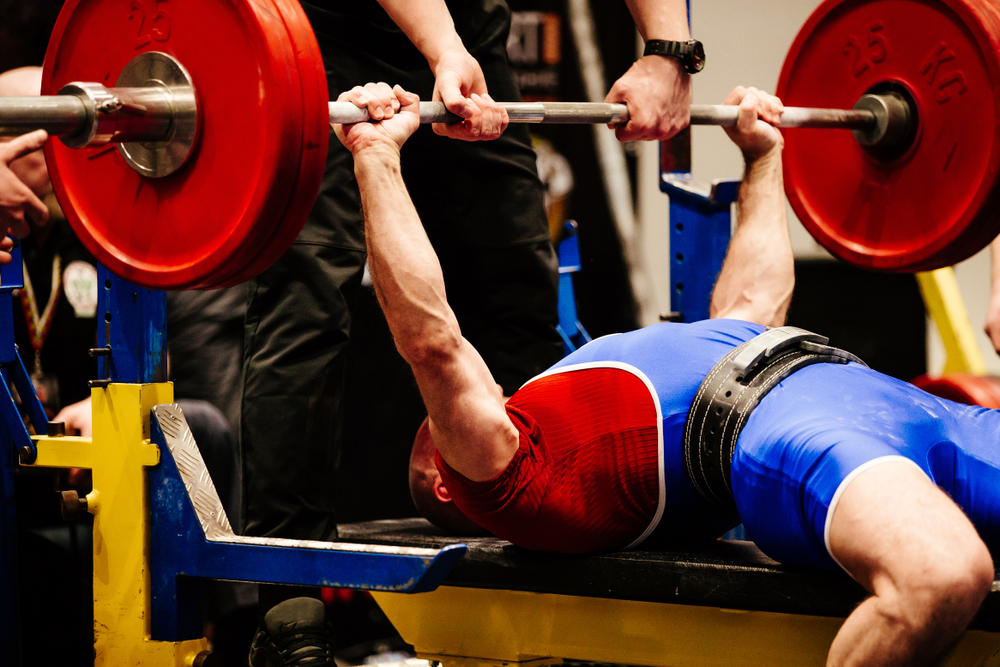“How much do you bench?”
Let’s cut to the chase. Not enough. We all want a bigger bench press. It doesn’t matter how much you bench, we all can and should be doing better.
The bench press is an iconic lift in the mind of the lifting and non-lifting public alike and it has been for at least the last 60 years. Because of this, there are almost as many ‘secret’ bench press hints and tips as there are gyms. And just like gyms, not all of them are good.
In this article I’ll be looking into and evaluating three tips that are often recommended for increasing your bench. One great, one good, and one garbage.

Great bench tip: lift faster to get stronger
All lifts are broken into two sections – concentric and eccentric. The concentric portion of a bench press is the explosion from chest to lockout, with the eccentric portion being the lowering back to the chest.
Scientists in Rome took two groups of bench-pressers, all in their 40s who had been training for nearly 20 years. One group was instructed to carry on benching as they had ever done, and the other group was instructed to follow a specific tempo for benching. The did this twice weekly for a couple of weeks.
The table below shows that that the SPS (the group that were doing it at their own speed) had a naturally longer, slower concentric phase than the FPS (the group that were doing it under strict instruction) who were told to use a longer eccentric phase and a quicker press.


Excuse all the confusing jargon – the findings are simple. When the scientists asked the two groups to retest their maximal bench three weeks later, they found that the group with the shorter, quicker concentric phase and the longer eccentric phase increased in strength by 10.2%.
So, what are the implications? Powerlifters have long known that what they called “speed work” increases overall strength. Spend a 4-week training block focusing on speed in the concentric and being careful and controlled in the eccentric and you could put some real pounds on your bench in a short amount of time.
This is a ‘great’ tip because it doesn’t matter at what stage of your lifting career, you can always focus on moving that bar more quickly and more efficiently. Whether you have one plate, two plates or four plates a side, you should concentrate on throwing the weight up and speedily as possible. If you are fast, you are strong.
Good bench tip: use a wider grip

Lots of bro science arguments have erupted over the ideal hand placement on the bench press. Some prefer a close grip meaning that their triceps are more involved in the lift, whereas others prefer as wide a grip as possible meaning the lats are more involved and the bar has a slightly shorter path to the chest.
A group of scientists (real ones, not bro scientists) set out to study this and settle the debate once and for all. They took a group of national and international level powerlifters with a stack of medals between them and put it to the test. They got each lifter to test their 6RM in a range of incline and decline positions, and with a range of grips. They found that with a medium or wider grip the 6RM load was between 5-11% higher than with narrow grip.
The implications for this on your training should be clear. Use a range of grips where possible, at different points in your cycle. Narrow grip (also called close grip) is a useful tool because it engages the triceps more and so works to build mass in those muscles as well.
The reason this is only a ‘good’ tip and not a ‘great’ one owes to the fact that the athletes were all at the top of their game and highly trained. If you are just getting started in the strength game, then playing around with grip width is not your priority. It is more important that you learn the fundamentals of the lift before tinkering to this extent.
Garbage bench tip: use unstable weights for better activation
Benching with an uneven weight has become very fashionable recently. In my gym I’ve seen people with a plate on one side and a kettlebell tied to a band on the other and on Instagram I’ve seen all sorts of monstrosities. The theory, such as it is, is that by having an uneven load on each side of the barbell your muscles are forced into action to counterbalance, thus sparking off new neural pathways and leading to you getting stronger and more muscular. At least, that’s the theory.
Researchers at California State University put this to the test, getting 20 males who all have a history of strength training and asking them to perform 3 reps on the bench. First time with a normally loaded barbell and then again with a 16kg Kettlebell attached to the bar by a rope, making the weights swing and the bar unstable.
And they found?
Well, not a lot.


There was no statistically significant difference between muscle activation in the classic bench press compared to the unevenly balanced one.
The conclusion? Loading your bar unevenly might be a fun way to break up training monotony, it isn’t going to have much impact on your strength or muscular development. So it’s probably not worth the effort. The researchers themselves concluded that “a lack of difference between conditions in this study demonstrates that there appears to be no advantage or disadvantage to the use of an unstable load in the bench press.”
This tip is a ‘garbage’ one because it might look cool but sometimes a gimmick is just a gimmick. Don’t be swayed by fancy tricks and Instagram Personal Trainers. Stick with the basics, do them well and you will thrive.
Conclusions
Three awesome curl variations to get big guns in 2022
The ‘c word’ can be taboo in the strength world. To bodybuilders, curls are a staple part of their training diet. To strength athletes and powerlifters, curls can seem to be something of a waste of time and often scornfully dismissed as vanity.
However, if you’re going to be moving any serious amount of weight in your lifting career, you will need all your muscles, tendons and ligaments playing their part – not least your biceps and forearms.
Not all curls are created equal and not all of them are appropriate for the discerning strength athlete.
Click here to read everything you need to know about taking your arm development to the next level!
Not all bench press tips are created equal. By all means give them a try but be prepared to think critically about what you are experiencing and whether it is having any meaningful impact on your strength. If you take a piece of advice and after three or four weeks you don’t seem to be making progress, scrap whatever it is you’re doing and try something else.
If you are a beginner, almost anything will work well because almost everything is better than doing nothing! Listen to the experienced people in your gym if they give you advice but be prepared to do your own research too. Happy benching!


Don’t hesitate to email us at [email protected] for personalized coaching and a client questionnaire if you’d like DEDICATED tailor-made personal training on strength training, building muscle, losing fat, developing athleticism, and more — all to your liking, lifestyle, habits, and taste!
Otherwise, don’t forget to claim your FREE eBook detailing how to lose 20lb of fat while building muscle in 12 weeks! You can claim it here.
Alternatively, you can pick up a FREE eBook on fundamental strength principles offering an introductory workout program.











